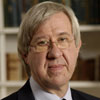February 16, 2012 - Washington, DC Overview and Agenda Photos
Data-Intensive Discovery in Science: The Fourth Paradigm
![]() Download Summary
Download Summary
![]() Download PDF Slides
Download PDF Slides
![]() Download Video
Download Video
Summary

The exponentially growing amount of data, attributed in part to advances enabled by the Federal investment in networking and information technology research and development over the last 20 years, is fundamentally changing science. Discoveries are increasingly driven by data; we derive more and more of our hypotheses from existing data collections. Data-intensive scientific analysis has been called the fourth paradigm of science because it is an entirely new way of doing science. While still in its infancy, it has the potential to become the next major advance in the evolution of the scientific method. All sciences, both physical and social, as well as some humanities, are increasingly data-intensive.
As datasets grow ever larger, the ability to analyze the information hidden in them becomes increasingly daunting. Developing the “Science of Big Data” is an integrative task unlike any in science before. It requires the collaboration of statisticians, computer scientists, and disciplinary experts who can merge their skills to create new tools (computer hardware and software), new techniques (algorithms and statistics), and a new methodology that yields discovery through data-driven rather than hypothesis-driven inquiry.
Astronomy has traditionally been data-driven, and thus the community has been at the forefront to embrace this new approach to science. Data from the Sloan Digital Sky Survey has been used by more than a million people outside the professional communities, yielding some unexpected discoveries, and demonstrating how the Internet and advanced computing technologies have led to the emergence of a “long tail” of scientists.
Alexander Szalay
 Alexander Szalay is the Alumni Centennial Professor of Astronomy at the Johns Hopkins University, and professor in the Department of Computer Science. He is a cosmologist, working on the statistical measures of the spatial distribution of galaxies and galaxy formation. With Jim Gray, he architected the Science Archive of the Sloan Digital Sky Survey. He was the project director of the NSF-funded National Virtual Observatory. He has written papers from theoretical cosmology to observational astronomy, spatial statistics and computer science. He is a corresponding member of the Hungarian Academy of Sciences, and a fellow of the American Academy of Arts and Sciences. In 2004 he received an Alexander Von Humboldt Award in Physical Sciences, in 2007 the Microsoft Jim Gray Award. In 2008 he became Doctor Honoris Clausa of the Eötvös University.
Alexander Szalay is the Alumni Centennial Professor of Astronomy at the Johns Hopkins University, and professor in the Department of Computer Science. He is a cosmologist, working on the statistical measures of the spatial distribution of galaxies and galaxy formation. With Jim Gray, he architected the Science Archive of the Sloan Digital Sky Survey. He was the project director of the NSF-funded National Virtual Observatory. He has written papers from theoretical cosmology to observational astronomy, spatial statistics and computer science. He is a corresponding member of the Hungarian Academy of Sciences, and a fellow of the American Academy of Arts and Sciences. In 2004 he received an Alexander Von Humboldt Award in Physical Sciences, in 2007 the Microsoft Jim Gray Award. In 2008 he became Doctor Honoris Clausa of the Eötvös University.
The materials on this webpage, including speakers' slides and videos, are copyright the author(s).
Permission is granted for non-commercial use with credit to the author(s) and the Computing Community Consortium (CCC).


